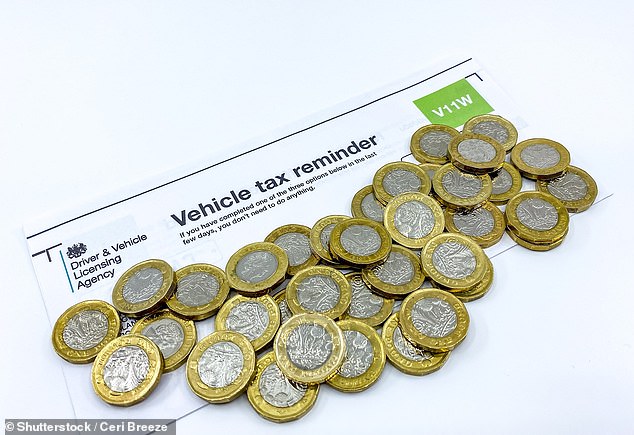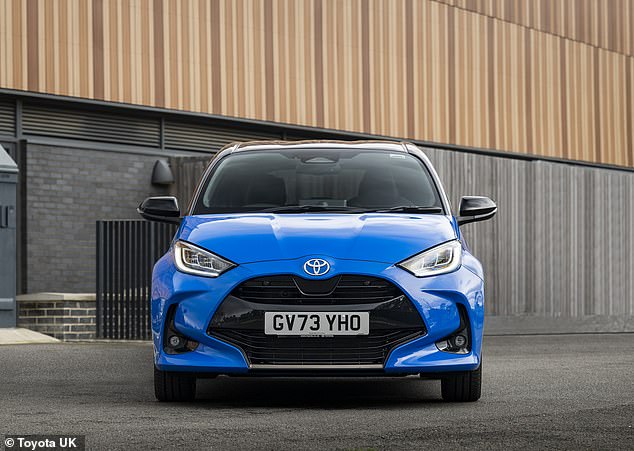By ROB HULL
Updated:
The cost to tax your car will likely rise this year as Labour oversees the biggest shake-up to Vehicle Excise Duty (VED) in almost a decade.
Not since April 2017 – when the Tories introduced a flat standard rate of car tax and the expensive car supplement – has VED undergone wholesale changes of such magnitude.
From 1 April 2025, buyers of new petrol and diesel cars are being clobbered with doubled first-year VED rates.
Meanwhile, EV owners no longer benefit from a car tax exemption and will be forced to pay into Treasury coffers for their car for the very first time.
In fact, most owners of cars new and old will feel the pain of Labour’s tax raid on motorists this year.
So, how exactly do the VED increases impact you?
This is Money has detailed all the changes based on the age of the car you drive, so you can see how much you will pay compared to last year.

I’M BUYING A NEW CAR AFTER 1 APRIL 2025
When motorists buy a new car, they pay a first-year tax rate – commonly known as a ‘showroom tax’ – based on its CO2 emissions, with costs increasing for higher polluters.
This showroom tax is typically included in the price of a new motor when a customer places the order.
And it’s first-year car tax rates that will see the most dramatic increases under new rules introduced by Labour.
Rachel Reeves in her Autumn Budget confirmed that first-year VED rates for all petrol and diesel cars – and many hybrids – will double from 1 April 2025 in what experts dubbed a stealth tax on the combustion engine.
Exemption for EVs has also been lifted, though new zero-emission models will incur only a £10 showroom tax – an ultra-low rate that will remain unchanged until 2029-30, as part of Labour’s effort to incentivise sales of greener cars.
However, the end of tax exemptions for EVs could see buyers in the next 12 months incur far greater costs further down the line.
That’s because all new electric cars purchased for more than £40,000 this year will incur the ‘expensive car supplement’ over the subsequent five years (from 2026-2031) on top of the standard rate.
An end to exemption from VED for electric cars – originally signalled by the former Conservative Government in 2022 to make the ‘tax system fairer’ – will also see new EVs costing over £40,000 from 1 April 2025 incur the same expensive car supplement (ECS) levied on pricey petrol and diesel models.
This luxury car tax impacts cars with a recommended retail price (RRP) over £40,000 when new and is paid on top of the standard rate for five years (from year two to year six).
This premium tax was introduced in 2017 and has proven an unwelcome hit to the pockets of motorists purchasing larger models, particularly expensive SUVs.
The ECS has increased from £410 to £425 this is added to the £195 standard rate and means owners of pricier cars will be hit with an annual tax bill of £620.
With seven in ten new EVs due to enter the road this year expected to cost over £40,000, owners are likely to incur a yearly £620 VED outlay from 2026 until 2031.
| Emissions (g/km) CO2 | First-year VED for new petrol, diesel, hybrid and electric cars | Increase |
|---|---|---|
| 0 | £10 | £10 |
| 1-50 | £110 | £100 |
| 51-75 | £130 | £100 |
| 76-90 | £270 | £135 |
| 91-100 | £350 | £175 |
| 101-110 | £390 | £195 |
| 111-130 | £440 | £220 |
| 131-150 | £540 | £270 |
| 151-170 | £1,360 | £680 |
| 171-190 | £2,190 | £1,095 |
| 191-225 | £3,300 | £1,650 |
| 226-255 | £4,680 | £2,340 |
| Over 255 | £5,490 | £2,745 |
While showroom tax on EVs will be incredibly low, anyone buying a car with a combustion engine will be forced to pay a huge amount more than they would have done previously.
The smallest increase is £100 for new cars emitting between 1 and 75g/km CO2. This is exclusively plug-in hybrids vehicles (PHEV).
But for all new cars that produce over 76g/km CO2, first-year VED rates have doubled.
Diesel models that fail to adhere to the latest RDE2 standard are taxed one band above their official emissions. For instance, a non-RDE2 diesel emitting 144g/km would move up a band and cost £2,190 in showrooms tax.
Greener cars get hit
Hybrid cars emitting just 76-90g/km CO2 cost £270 in showroom tax, up from £135 previously.
New vehicles emitting between 91-100g/km CO2 – like Toyota’s Yaris hybrid (which puts out 91g/km CO2) – now cost £330 to tax for the first year, up from £195.
Other economical new cars emitting between 101-110g/km CO2 have suffered the first-year tax hike, rising to £390 from £195 previously.
Families looking to buy a brand new 1.3-litre mild-hybrid petrol Nissan Qashqai (which emits 144g/km of CO2) pay £540 (up from £270) under the new rules.


Polluting cars get walloped
However, the biggest financial sting impacts buyers of the most polluting vehicles.
Showroom tax on all petrol and diesel cars with emissions of 191-225g/km CO2 – like a new mild-hybrid diesel Range Rover putting out 194g/km – has been upped to £3,300 (from £1,650).
First-year VED costs for brand new vehicles putting out 226-255g/km CO2 (like the BMW M4) have been hiked to £4,680 (from £2,340).
But the biggest increase of all is on cars with CO2 emissions in excess of 255g/km, which for the first year will cost a staggering £5,490 (up from £2,745) to tax.
This will be incurred by a small number of popular models, including the Ford Mustang and V8-engined Land Rover Defenders, Range Rovers and Range Rover Sports.



MY CAR WAS REGISTERED BETWEEN 1 APRIL 2017 AND 31 MARCH 2025
If you own a car that was first registered between 1 April 2017 to 31 March 2025, the standard rate of car tax, which is paid from the car’s second year onwards, has also increased… especially if you’re driving an EV.
This has been upped in-line with RPI from £190 to £195 a year across every fuel type – including hybrid and electric cars.
Petrol, diesel and hybrid cars dating back to 2019 with an RRP over £40,000 will be pay the expensive car supplement of £425 this year.
This is levied – on top of the £195 standard rate – on cars with a £40k-plus list price for five years from the second year of registration to the sixth, taking the annual outlay to £620 irrelevant of if it produces low CO2 or extremely high levels of carbon dioxide.
| Fuel type | Standard tax rate for cars costing less than £40,000 | Increase | Standard tax rate for cars costing more than £40,000 | Increase |
|---|---|---|---|---|
| Petrol, diesel, hybrid and electric cars | £195 | £5 for petrol and diesel cars, £15 for hybrids, £195 for EVs | £620 | £15 for petrol and diesel cars, £30 for hybrids, £620 for EVs |
| *models with a ‘list price’ (the published price before any discounts) of more than £40,000 to pay an additional premium tax of £425 for the first 5 years of the standard rate | ||||
For those who bought a new £40,000 petrol or diesel in March 2024 and plan to keep it for six years, they would effectively fork out at least £3,100 on VED alone between now and 2029.
As previously mentioned, the expensive car supplement is also being levied on electric cars for the first time. However, only new £40k+ EVs purchased after 1 April 2025 will be subject to the supplementary premium tax – meaning the ECS will not hit these vehicles until next year.
MY CAR WAS REGISTERED BETWEEN 1 MARCH 2001 AND 31 MARCH 2017
For older petrol and diesel cars registered between March 2001 and March 2017, VED continues to be classified by lettered bands (from A to M) based on CO2 emission outputs.
With the EV exemption ending, owners or older electric cars registered over eight years ago now incur a £20-a-year VED rate – as will ultra-low-emission hybrid, petrol and diesel models emitting less than 100g/km CO2.
For all other vehicles, an RPI increase will impact those emitting over 121g/km.
Annual VED costs will rise between £5 and £25 for these motors.
It means the most polluting models with CO2 emissions over 255g/km will be forced to splash out £760 annually on car tax.
| VED Band | CO2 emissions (g/km) | Standard tax rate for petrol, diesel, hybrid and electric cars | Increase |
|---|---|---|---|
| A | Up to 100 | £20 | £20 |
| B | 101-110 | £20 | £0 |
| C | 111-120 | £35 | £0 |
| D | 121-130 | £165 | £5 |
| E | 131-140 | £195 | £5 |
| F | 141-150 | £215 | £5 |
| G | 151-165 | £265 | £10 |
| H | 166-175 | £315 | £10 |
| I | 176-185 | £345 | £10 |
| J | 186-200 | £395 | £10 |
| K* | 201-225 | £430 | £15 |
| L | 226-255 | £735 | £25 |
| M | Over 255 | £760 | £25 |
| *Includes cars emitting over 225 g/km registered before March 23, 2006 | |||
MY CAR WAS REGISTERED BEFORE 1 MARCH 2001
If you own a car that’s more than 24 years old – registered before 1 March 2001 – you will also need to pay more in car tax this year.
VED for cars this old is split into just two bands based on engine size – up to 1.55 litres and over 1.55 litres.
For those in the lower group, the rise is £10 a year, up from £210 to £220.
For the larger engine capacities, ministers have hit them with a £15 increase, rising from £345 to £360 from 1 April 2025.
| Engine size | Standard rate* for petrol and diesel cars | Increase |
|---|---|---|
| Up to 1549cc | £220 | £10 |
| Over 1549cc | £360 | £15 |
MY CAR IS OVER 40 YEARS OLD
Under VED rules, any car that was registered over 40 years ago is no longer hit with car tax.
That means all cars registered before April 1985 is already eligible for ‘historical vehicle taxation’ exemption.
However, it is important to note that it is a vehicle keeper’s responsibility to apply to the DVLA for a vehicle tax exemption so they can issue an updated log book to clarify that the car is eligible for charge-free historic vehicle tax.
You can find how to apply for historic vehicle tax on the Gov.uk site.
Some links in this article may be affiliate links. If you click on them we may earn a small commission. That helps us fund This Is Money, and keep it free to use. We do not write articles to promote products. We do not allow any commercial relationship to affect our editorial independence.









